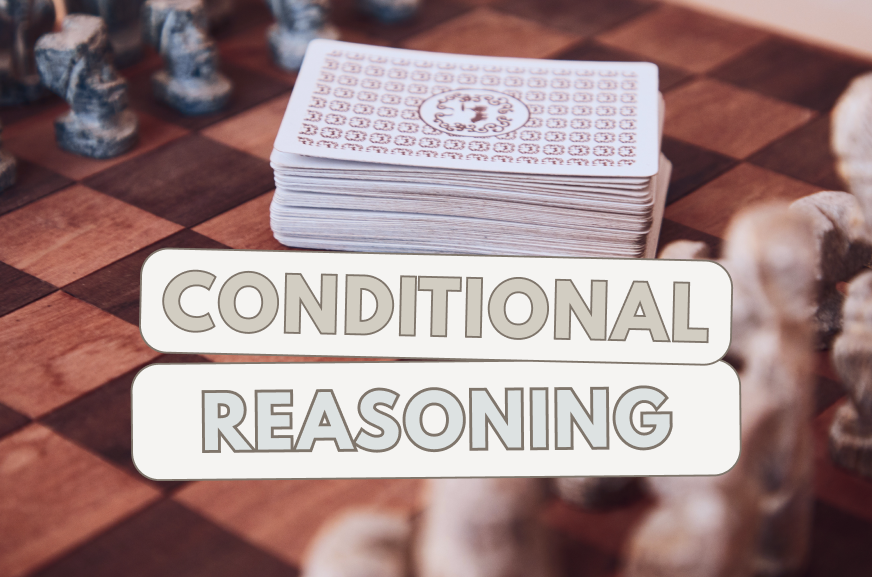The following two rules are extremely common in Grouping: In-Out / Selection games, but they give test-takers a lot of trouble.
These rules come up in other types of Logic Games, too. Make sure you can recognize them at a glance and instantly know what they mean.
Please note: “~” is a symbol meaning “not.” I’d use a slash (“/” ) through a letter in the below examples to indicate “not.”
However, it doesn’t come out well when typed, so I’m not using any slashes in this blog post. If you prefer the slash (I do), use it instead.
Rule #1:
Positive Variable -> Negative Variable = + –> –
Original: X -> ~Y
Contrapositive: Y-> ~X
Meaning: at least one does NOT occur, and maybe both will not.
Example:
If I eat cookies, then I don’t eat donuts.
If I eat donuts, then I don’t eat cookies.
Therefore, I cannot eat at least one of them, but perhaps I’ll eat neither.
Whenever you see a positive sufficient condition (the one before the arrow), and a negative necessary condition (the one AFTER the arrow), this means you can never select both, so at least one will not be selected.
In other words, you must always lack at least one of the two. However, there’s no reason you can’t lack both.
LSAT Examples:
PrepTest 33, Game 2 – birds in the forest (December 2000 – in Next 10 Actual, page 177):
Original: Harriers -> ~Grosbeaks
Contrapositive: Grosbeaks-> ~Harriers
Meaning: The forest cannot contain both Harriers and Grosbeaks – it will always lack at least one of the two, and maybe it will lack both.
PrepTest 36, Game 1 – fruit stand (December 2001 – in Next 10 Actual, page 278):
Original: Kiwis -> ~Pears
Contrapositive: Pears -> ~Kiwis
Meaning: The fruit stand cannot carry both Kiwis and Pears – it will always lack at least one of the two, and maybe it will lack both.
Rule #2:
Negative Variable -> Positive Variable = – –> +
Original: ~X -> Y
Contrapositive: ~Y-> X
Meaning: at least one MUST occur, and maybe both will occur.
Example:
If I don’t eat peas, then I must eat carrots.
If I don’t eat carrots, then I must eat peas.
Therefore, I must always eat at least one of the two, but there’s no reason I can’t have both.
At this point, students often ask, “Why is it possible to have both?”
Answer: Because the rule has no policy for what happens when you already have one of the two.
This rule only has a policy for what happens if I don’t eat one (I must eat the other). It has no policy for what happens when I already ate one (or am going to eat). This is why nothing stops me from eating both. There’s simply no rule against it.
The only thing this rule means is I can’t LACK both.
LSAT Examples:
PrepTest 33, Game 2 – birds in the forest (December 2000 – in Next 10 Actual, page 177):
Original: ~Jays -> Shrikes
Contrapositive: ~Shrikes -> Jays
Meaning: The forest cannot lack both Jays and Shrikes – it will always have at least one of the two, and maybe it will have both.
PrepTest 36, Game 1 – fruit stand (December 2000 – in Next 10 Actual, page 278):
Original: ~Tangerines -> Kiwis
Contrapositive: ~Kiwis -> Tangerines
Meaning: The fruit stand cannot lack both Kiwis and Tangerines – it will always have at least one of the two, and maybe it will have both.
For the birds in the forest game, I would summarize the rule as:
J
S
JS
Every valid list of birds in the forest will fall into one of those three categories – one is in, the other is in, or both are in.
For the fruit stand game, you might summarize the rule as:
K
T
KT
Every valid list of fruits in the fruit stand will fall into one of those three categories – one is in, the other is in, or both are in.

